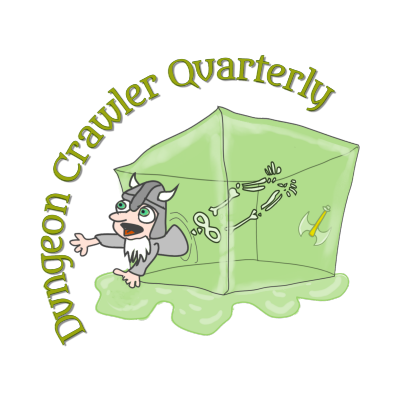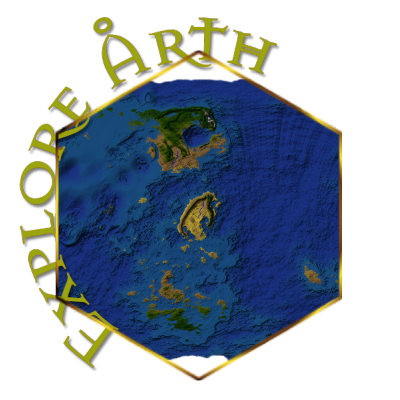Creation Myth
In a time before time, the seven creator gods came to this plane to create the Well of Urð. Hɛxidæ first created the firmament from the ether, giving the other gods a canvas on which to work. Hɛlaias then created the great balls of fire to become the suns that shine in the heavens. JörÞfaðir then placed bodies of earth around those suns. Cryas then placed air on those worlds. The great mother Sesleth then graced the worlds with water and Sylvanus planted the seeds of life in those waters. Auctorus then polished the raw worlds, so that each of the elements could be represented in good measure. Joyed with the beauty the other gods had created, Hɛxidæ then finished creation by bestowing the weave of magic to those worlds. But Cryas betrayed the Old Ten and took victory for himself, driving Ǻrth into 10,000 years of winter. The ancient reptile people, dire elves, and deep gnomes fled underground to survive, but never forgot. The dwarves and elves clung tight to their hearths and furnaces, while man and orc quietly endured the long cold darkness in small bands where Ǻrth could sustain them.
Great ages flowed before Cryas was driven to the edges of the world, sages have great debates as to the source of Cryas’ downfall and each race of Ǻrth has its own tale of how an ancient hero of their species was responsible for the feat. The truth of the matter may never be uncovered, but never-the-less, warmth did return to the world.
As life prospered, new gods and races rose and fell in the natural cycle, shaping the world into that which we know now. The first significant civilization on the continent known as Auctorus was that of the Founder Gnomes. They built a great and expansive empire, resplendent with great works of art and machinery. But with time their empire fell into ruin due to matters lost in the depths of time.
It was two thousand years before Auctorus saw the rise of another great empire. This time it was the humans’ turn to strive for glory. Their empire again stretched the width and breadth of Auctorus, leaving only the far north reserved for uncivilized barbarians. But the human empire was ruled by ambition and greed—enslaving lesser races and exploiting the weak. Eventually, this led to the fall of their Great Empire, leaving humanity to flee their great cities—to live as refugees in the wilds and ruins.
The Historic Empire
Nearly five hundred years ago, a great human general Josip united the human city-states of the south. He drove the goblinoid races to the fringes of civilization and created a national identity to unify the xenophobic humans; however, the Empire itself did not begin to form until Josip’s granddaughter Trenna the Great took the mantle of Emperor. Trenna used gnoll slave labor to commence building a vast road network to connect human settlements. She solidified the common laws of the south into what became known as the Criterion and established a class of Law Givers to travel the Empire as enforcers and magistrates. She then used the Imperial treasury to subsidize new trade both within the empire and with demihuman dominions. The Empire blossomed under Trenna’s guidance and provided the infrastructure needed for the Empire to pursue great efforts in science and magic. By the end of Trenna’s 70-year reign, the entire continent of Auctorus had been explored, and nearly all settlements of any size paid either tax or tribute to the Empire.
There was always a dark side of the Empire; its focus on the accumulation of wealth often promoted an atmosphere where the weak were systematically victimized for the enrichment of the strong. Slavery flourished, first with gnolls and other humanoids, then with the addition of barbarian humans, then gnomes and miloi. As the culture of the Great Empire became increasingly decadent, the beings in servitude became increasingly desperate. Isolated slave rebellions were crushed with astounding cruelty. At first, this seemed to quell the rebellious nature of the slaves, but in time it made the lower classes sympathize with the victims of slavery.
A vast underground movement began to subvert the imperial government and the wealthy merchant houses. Secret priests organized hidden masses and readied the laborers to overthrow their masters; brave rogues started stealing powerful magics from complacent nobles, and sympathetic military officers began to ready their units for a coup.
The details of the eventual rebellion are lost to the fogs of time, but this much is known: The gnoll slaves who were kept for heavy labor were the first to rise—organized by priests spreading the word of Nefandus, their martyred leader. The gnolls began killing every human they met, fighting their way out of the cities.
When the army was dispatched to track down and exterminate the gnolls, disloyal units attacked the centers of government. Then, in the confusion, other groups of slaves began violent revolution, supported by a countless number of lower-class workers.
Unable to rely on the army to put down a state of general rebellion, the Emperor called his most potent priests and wizards together. He bade them open a great portal to the lower planes and pull forth powerful minions to bind into his service. This is when the carnage truly began…
During the Great Fall, nearly all human settlements larger than village size were destroyed either by rebelling slaves or marauding demons. Those few communities which remained were quickly overrun with refugees. These refugees carried disease and placed too much pressure on the available agriculture, eventually causing the collapse of settlements they fled to for safety. In the end, humanity across Auctorus was scattered into the wilds, forced once again to live a life of hunting and gathering.
The Council of Peers
From the ruins of the Great Empire came a expanse of warring city-states. After a hundred years, clerics of the Old Gods began working together to form coalitions between city-states, so that ministering the faith would be less complicated and less dangerous.
In the end, the Law of Peers was established to give politics a set of ground rules and loosely associating the nobility in the Council of Peers. The Council has little actual power but provides an opportunity for nobles to meet under peaceful albeit intrigue-filled circumstances.
The council meets every third year at a location voted on by its members at the previous gathering. According to the Law of Peers, each noble will be afforded some lots or votes according to his or her rank with barons having but one lot and kings having five lots. While on the surface, this looks like a measure of equity between the peerage, it is generally a grave offense for a noble to cast a lot in opposition to his or her liege lord.
The Law of Peers also defines the requirements a noble must fulfill to attain a given rank. Although, most titles are hereditary and do not change up or down except as the result of war.
The King and the Wars
It was two hundred years after the fall of the Great Empire when humanity began to coalesce into new societies, the Council of Peers united the various human lords of the Old Empire and Nearnorth. After years of peaceful diplomacy, the leadership of the Duke of Cabalan was recognized, and the great nobles of Auctorus agreed to bend the knee and grant Cabalan the title of King. For 70 long years the King of Auctorus ruled wisely and brought prosperity to the realm, but a series of accidents robbed him of his heirs before his passing. When the king grew sick, the Council of Peers met in the capital to determine the fate of the great Kingdom of Auctorus. Little is known about what exactly happened on that day, half a century ago, but the results again changed the face of Auctorus. While the Council of Peers was in session, something happened which sparked a civil war and razed the capital city, many get nobles, great mages, and church leaders died that day, and with each death, a struggle for power began in that person’s organization.
After 10 years of particularly vicious fighting the war burned itself out, and the kingdom fragmented, many areas were abandoned, to become ruled of goblins and orcs as no armies of man or dwarf could hold them back. A new stability has grown in the decades since, but again the greatness of the past is allusive and common people struggle as humanoids and monsters of all kinds have grown in numbers and again threaten the very survival of human settlements, but the time is ripe for brave adventurers of all races to seize the opportunities the world affords and to shape Auctorus into a new image.














Recent Comments